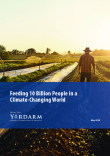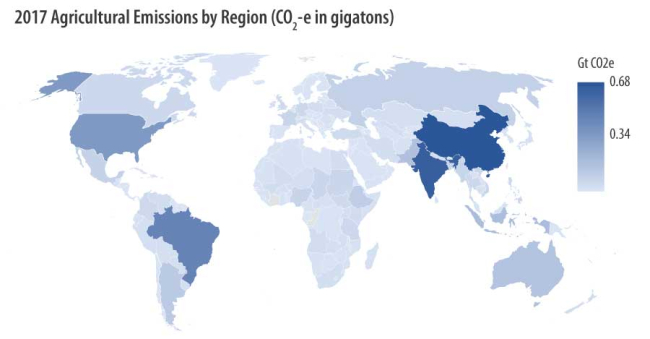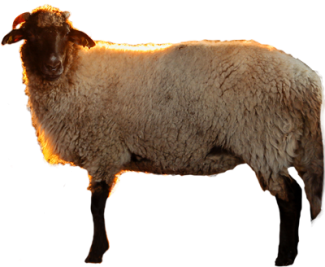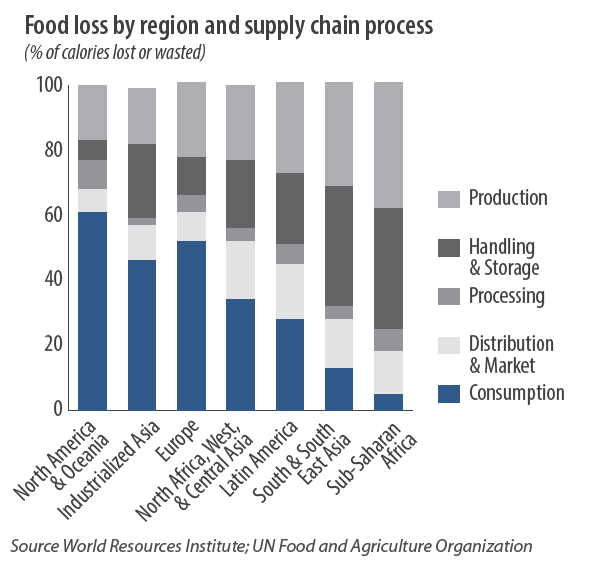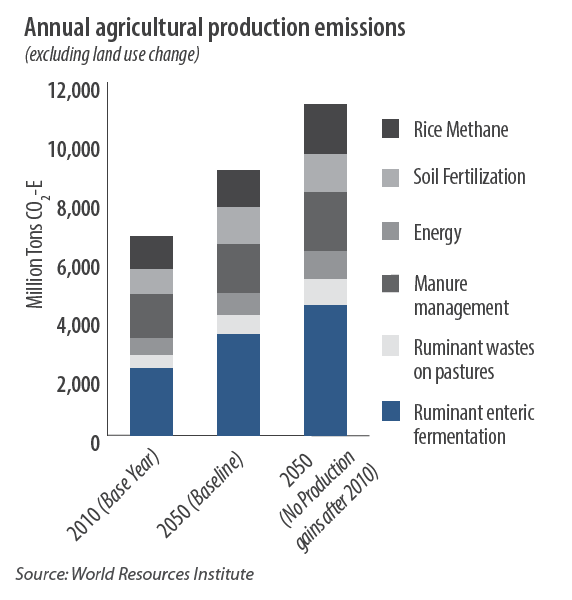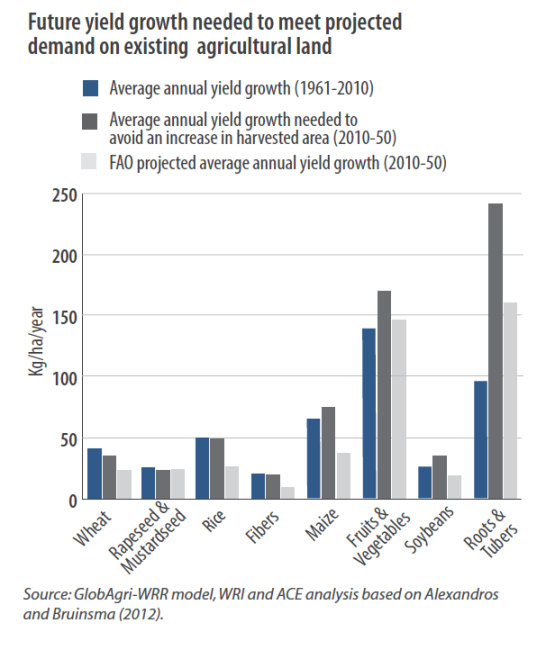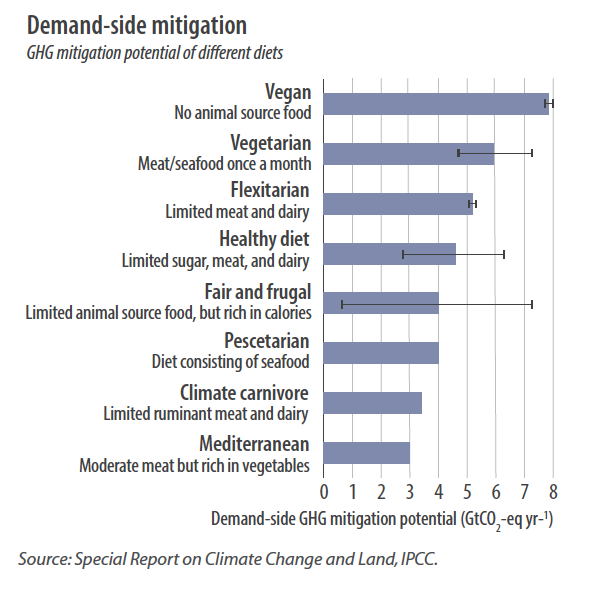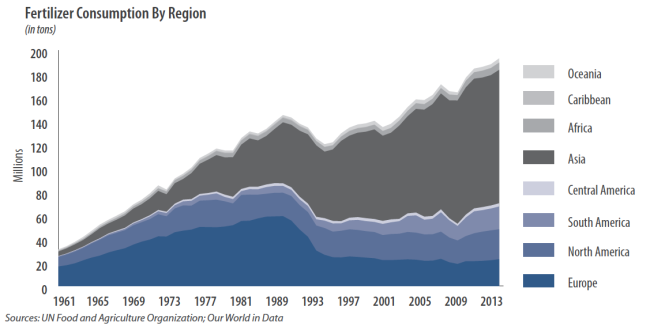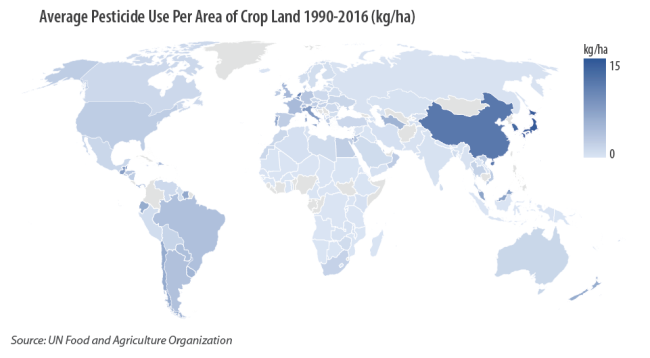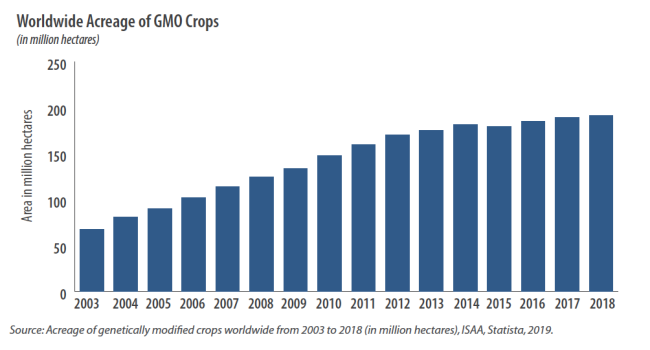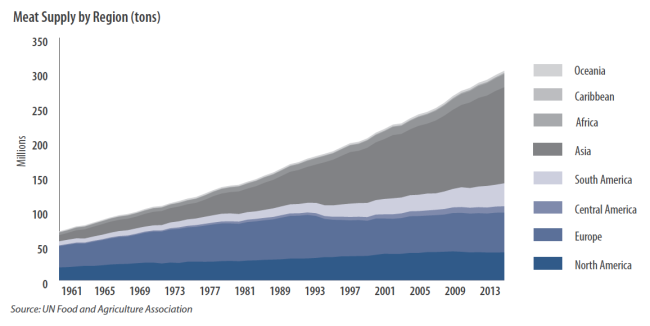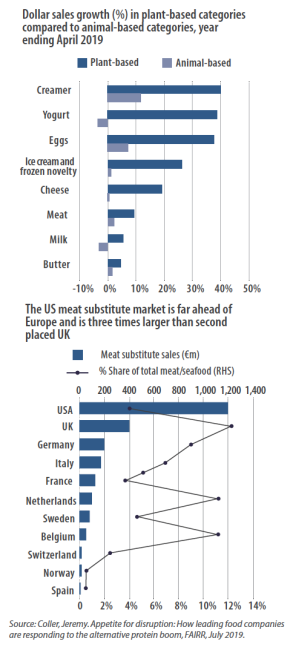Back to Top
Feeding 10 Billion People in a Climate-Changing World
Download a PDF:
By 2050, nearly 10 billion people will live on our planet.
In order to sustain this population and our growing demand for resource-intensive animal-based foods, the World Resources Institute estimates that crop production will need to increase by 56% from a 2010 baseline.1 In 2010, agriculture accounted for approximately 24% of all greenhouse gas (GHG) emissions, while using 50% of the world's vegetated land and 70% of the world's fresh water.2 The fragility of agricultural systems undermines the growth required amidst resource constraints. With meat processing plants closing temporarily, wholesale sugar and butter prices plummeting, and food intended for bulk buyers being thrown out while food banks face increasing demand, the coronavirus pandemic has exposed how added stress can push food supply chains to their limits.
We cannot formulate climate change solutions or expect to reach GHG emissions targets without a comprehensive overhaul of our current agricultural system. The World Resource Institute estimates that without proactive mitigation efforts, GHG emissions from agriculture and land-use changes will amount to 15 gigatons (Gt) of carbon dioxide equivalent (CO2-e) by 2050, compared to 12 Gt in 2010. That's significant, considering worldwide CO2-e emissions must be held to 21 Gt to maintain global warming below 2°C, a figure widely noted as the threshold for avoiding catastrophic climate change. With annual emissions projected to reach 70 Gt by 2050 under a business-as-normal scenario, we'll need to adhere to a four Gt annual limit if we expect to reach our goals.3
Mitigating 11 Gt of CO2-e annually by 2050 will require decreasing food loss and waste, changing animal protein consumption patterns, reducing methane emissions from enteric fermentation (cow flatulence), and increasing crop yields, among other tactics. To achieve this audacious goal, business will need to develop a variety of solutions, including advances in chemical and biological agriculture technology, adaptive crop genetics, precision agriculture tools, and animal protein alternatives. Among these, animal protein production and associated land use changes4 constitute the single greatest source of agricultural GHG emissions.
How climate change threatens our food supply
Agricultural production is highly susceptible to temperature increases and variability in precipitation; both are hallmarks of climate change. Temperature and precipitation changes have already been linked to lower crop yields, with the worst impacts on wheat and corn. Further research shows that for each degree Celsius increase in global temperature, production is expected to fall by 6% for wheat, 7.4% for corn, and 3.1% for soybeans. In addition to the direct impacts associated with temperature and precipitation, the likely spread of pests and disease may also severely impact production.5 While higher CO2 levels are associated with improved crop productivity, such crops have lower nutritional values.6
As the earth has already warmed approximately 1°C above pre-industrial levels, failing to limit warming to below 2°C is a near certainty.7 Should warming exceed 2°C, corn yields in some regions could fall by up to 20%. Warming beyond 3°C could lead to a collapse of corn crops in some areas.8 Corn is the world's second most widely produced food crop, after sugar cane, making it the largest crop with any nutritional value.9 A meta study on vegetables and legumes found that a 4°C increase would lead to a mean yield reduction of 31.5%.10
The effects of climate change on agricultural production aren't limited to people and businesses directly involved in farming, as record floods in the midwestern US have shown. After the wettest year on record, agricultural suppliers struggled to sell seeds, pesticides, and fertilizers to farmers. Corteva CEO Jim Collins stated during the 2019 spring planting season, "It's got to be the worst ever that we've seen."11 Although it's nearly impossible to connect any single weather event to climate change, many scientists agree that climate change likely made 2019's flooding worse.12
Beyond the effects on crop yields and animal feed, climate change further exposes livestock to heat stress, water shortages, and pests. For instance, warming and extreme heat events are associated with lower growth rates, reproduction levels, and milk yields, as well as higher cow mortalities. What's more, higher temperatures are associated with increased methane production due to cow flatulence. This is especially concerning as methane has a much higher, albeit shorter-lived, global warming potential than CO2. All told, under a 2°C warming scenario, we should expect a 7-10% decline in livestock production.13 Warming in excess of 3°C presents even further risks to livestock production. While there is a lack of research quantifying the effects of climate change on livestock yields, heat stress already costs the US livestock industry between $1.7-$2.4 billion annually.14 Moreover, it is generally accepted that there will be major reductions in land suitable for animal agriculture should temperatures increase more than 3°C.15
Livestock producers already feel the pinch from rising feed costs that follow climate change related weather events. Prior to the 2019 spring deluge in the US, drought gripped corn growing regions of Brazil in 2016. That drought and resulting crop yield reductions drove up feed prices for meatpackers. In fact, one meatpacker attributed $95 million in losses to associated feed cost increases in 2016.16
DETRIMENTAL EFFECTS ON
AGRICULTURAL PRODUCTION
CASCADE TO FARM COMMUNITIES
AND SOCIETY AS A WHOLE
Detrimental effects on agricultural production cascade to farm communities and society as a whole. Statistics show a positive correlation between migration away from agricultural communities and global temperature increases.17 Given current geopolitics and the growing divide over immigration policy, climate change may exacerbate the issue. As historians, scientists, and political pundits debate the link between climate change and global conflict,18 tension and friction continue to build from reduced food supplies, limited water availability, and increased migration. The US military ominously refers to climate change as a "threat multiplier." Adding to this, climate change could push three to 16 million people into extreme poverty by 2030, largely due to its effects on agriculture and food prices.19
What can we do about it?
Reduce food loss and waste
At this time and under current consumption patterns, the world already grows enough food to feed 10 billion people.20 Unfortunately, more than one third of all food produced is lost or wasted,21 and approximately 820 million people remain undernourished.22 Food loss and waste generates approximately 8% of total human-caused GHG emissions.23 According to the World Resources Institute, cutting food loss and waste by 25% would eliminate 15% of the total 11 Gt of GHGs we need to eliminate from agricultural sources.24 UN Sustainable Development Goal 12.3 aims to cut global food loss and waste in half by 2030, helping to put this issue on corporate and government radars.25
Globally, food loss and waste amounts to approximately $1 trillion in economic losses. The reasons for loss and waste vary significantly depending on geography. In developing countries, most food loss occurs in the production, handling, and storage stages. These losses stem from inadequate technology, including outdated harvesting equipment, limited refrigeration, and poor infrastructure, that slows the process of bringing food to market. In developed countries, food loss and waste occurs mainly at the consumption stage, primarily due to excessive serving sizes and confusion around spoilage dates. "Sell by" and "best before" date stamps on products that have little bearing on food safety nevertheless provide concerned consumers justification to toss out edible food items. While such behavior may be hard to change, through a variety of food labeling and marketing campaigns, the United Kingdom was able to cut household food loss and waste by 21%.26
Reduce methane from livestock flatulence and burps
Yes, you read that correctly. Ruminants, such as cattle, sheep, and goats, digest food through enteric fermentation that produces methane expelled through flatulence and burps. This methane has a global warming potential that is 84 times more powerful than CO2 in the 20 years after its release.27 In 2010, enteric fermentation contributed approximately 19% of all agriculture and land-use change emissions and 33% of agricultural production emissions.28 What's more, ruminants lose anywhere from 2-12% of their energy intake through methane emissions from enteric fermentation, meaning a reduction in these emissions may lead to higher protein yields.29
Feed additives can reduce emissions associated with enteric fermentation. One study found that adding a particular type of seaweed can reduce methane emissions by up to 80%. Adding fats and oils to feed can reduce methane by 15-20%.30 Unfortunately, both routes have been associated with negative effects on animal health and productivity. One promising alternative is the chemical compound 3-nitrooxypropanol (3-NOP). Adding the compound to ruminant feed can reduce methane emissions up to 30% while animal growth rates increase.31
Increase crop yields
If we held current production efficiencies constant through 2050, most of the world's remaining forests would need to be converted into agricultural land. Converting forests into cropland alone would likely lead to climate disaster. In order to feed a world of 10 billion while also holding GHG emissions within the confines of a 2°C goal, crop yield improvements will need to surpass historic trends. We can achieve this in numerous ways, such as improved soil and water management, adaptive crop genetics, and intensified production on existing cropland. In order to achieve the needed GHG reductions, all three avenues must be explored. Increasing crop yields by 56% between 2010 and 2050 (versus a historic baseline of 48%) would address approximately 6% of the needed GHG mitigation.32
Change animal protein consumption patterns
Spoiler alert: You probably need to eat fewer hamburgers. Approximately 14.5% of all human activity-related GHG emissions are associated with animal agriculture.33 Ruminant meat and dairy production (e.g., cows, goats, and sheep) comprise the lion's share of these GHG emissions, predominantly caused by expanding pasture and cropland for feed. Ruminant meat consumption could grow by 88% between 2010 and 2050, and demand for all animal protein is expected to grow by 70%. Such growth is not sustainable; we must develop alternatives. Reducing ruminant meat consumption to the equivalent of 1.5 hamburgers per week could address half of the 11 gigatons of GHG mitigation needed.34
Science on the front lines
Advances in chemical and biological agriculture technologies
Higher crop yields, lower enteric fermentation, and more efficient food processing rely on significant advancements to biological and chemical compounds and processes. Since the 1950s, gains in crop yields have largely been fueled by widespread adoption of pesticides and the deployment of nitrogen and phosphorous fertilizers. In recent years, the use of these pesticides and fertilizers has come under increased scrutiny. After the World Health Organization classified glyphosate as a "probable human carcinogen," over 18,000 lawsuits were filed against Monsanto.35 Further research has shown that agricultural workers exposed to glyphosate, which is the most widely used herbicide in the US, have a 41% higher risk of contracting non-Hodgkin's lymphoma.36 In addition, a rise in glyphosate-resistant weeds "presents the greatest threat to sustained weed control in major agronomic crops."37
Increasing or even maintaining current food nutrient levels will require advancements to fertilizer production processes. Phosphorous fertilizers, for their part, are nonrenewable resources projected to be fully exploited within the next 50 to 100 years. Moreover, at current efficiency rates, feeding a world of 10 billion will likely exceed planetary boundaries for nitrogen and phosphorous use. In other words, sustained use at current levels will likely cause widespread aquatic "dead zones" such as those seen in the Gulf of Mexico and Chesapeake Bay.38
While the application of traditional pesticides and fertilizers help maintain current crop yields, new tools are needed to address anticipated shortcomings and increase crop and animal protein yields beyond historical averages. Such tools include pesticides with reduced toxicity, seed treatments that allow for reductions in pesticide and fertilizer use, and enzymes that allow livestock to more efficiently absorb nutrients. Analysts expect the crop protection market to have a 2.5% compound annual growth rate between 2018 and 2021, and biological and microbial segments within this wider market to grow by more than 10% and 13-17%, respectively.39
Probiotics provide biological plant protection suitable for use in organic-certified farms. Such products can increase yields by approximately 10%, in line with chemical pesticides. In addition to probiotics, lactates provide appealing biological pesticides. This natural acid, which athletes often associate with sore muscles, is biodegradable and replaces the need for petrochemicalbased pesticide solvents. By replacing petrochemicals, lactate-based solvents remove the associated volatile organic compound emissions and hazardous air pollutants. This provides a solution that reduces the environmental impacts of pesticides while upholding the efficacy in crop protection.
Enzymes present a particularly appealing solution as they can be used to address a variety of issues and are readily biodegradable. What are enzymes, you may ask? Enzymes are biological molecules (often proteins) that act as a catalyst for chemical reactions. They can help to break down and bind molecules to produce new substances.
One interesting application of enzymes is as a seed treatment. A biological solutions company has developed an enzymatic seed treatment that improves symbiosis between microbes and corn plants. This symbiosis helps corn plants develop stronger root systems, thereby improving the plant's access to nutrients. Another interesting application of enzymes is as a feed additive. Adding one particular enzyme to all chicken feed in Latin and North America could save up to 4.2 million tons of CO2 annually. Finally, enzymes provide additional solutions downstream in food processing where they can generate efficiencies, such as greater starch and gluten yields from grain milling, while also lowering water and energy consumption.
Whether it be developing chemical pesticides to combat glyphosate tolerant weeds, or using enzymes to improve yields from dairy cows, chemical and biological solutions are critical to agricultural productivity. To be sure, we can't discount the yield gains driven by traditional pesticides and fertilizers. Yet, it's clear that feeding a world with 10 billion people in the midst of a rapidly changing climate will require innovative solutions that reduce the environmental impacts associated with intensive agricultural practices.
Adaptive crop genetics
Adaptive genetics present another avenue in meeting global food demands amidst a rapidly changing climate. Developing these genetics will likely require both traditional crossbreeding and genetic engineering. In 2017, genetically modified field seeds accounted for approximately 54% of the world's commercial seed market, while conventional field and vegetable seeds accounted for 32% and 14%, respectively.40 The agricultural biotech market (largely comprised of genetically modified crops) in 2017 represented $20 billion in sales. By 2026, it could grow to $52 billion, an 11% compound annual growth rate.41
The most widely used trait in genetically modified organisms (GMO) is glyphosate resistance. In fact, more than 90% of corn, soy, canola, and sugar beets in the US have been modified to withstand application of the glyphosate herbicide.42 Beyond glyphosate resistance, the next most widely applied genetic modification allows plant production of the naturally occurring insecticide Bacillus thuringiensis (Bt). This trait is largely used in corn and cotton plants.
To date, there is no evidence that glyphosate-resistant or Bt-producing GMOs, in and of themselves, have caused negative human health effects (i.e., consumption of the crops has not harmed humans). However, exposure to the glyphosate herbicide has been linked to increased cancer rates. According to the World Resources Institute, "the merits of GM technologies lie primarily with traits other than glyphosate resistance or Bt." Such merits have already been recognized, for instance, in saving Hawaiian papayas from a virus that likely would have wiped out the plant. GMOs also show promise in defending soybeans from Asian soy rust, potatoes from potato late blight, and tomatoes from bacterial spot, among other threats. GMOs can also help crops develop tolerance to environmental hazards such as drought, heat, and floods. In addition to genetic modification, "genomics" presents an opportunity to improve crop yields through conventional breeding. This process allows seed breeders to apply genetic mapping and statistics to help predict desired traits.43 Such techniques can be especially effective; one study found increased yields of 30% for conventionally bred drought-tolerant corn.44
GMO technology is a controversial and polarizing issue. Both the concerns and proposed merits are warranted. Nevertheless, research shows that without breakthrough technologies, US corn yields could stagnate due to climate change.45 Globally, the situation could be worse. Research published in 2018 found that climate change that occurred between 1981 and 2010 reduced average global yields of corn, wheat, and soybeans by 4.1%, 1.8%, and 4.5%, respectively. Importantly, this analysis included the benefits associated with CO2 fertilization.46 With agricultural productivity in Africa and Asia facing significant negative effects due to climate change, and populations growing fastest in these regions, adaptive crop genetics will likely play a key role in ensuring food security in each region.47
The rise of glyphosate-resistant weeds presents a significant threat to modern agricultural systems. To combat these weeds, companies have developed crops that are tolerant to a host of herbicides beyond glyphosate. While this development is critical to maintaining current yields, such advances aren't going to bridge the yield gap needed to feed an evergrowing world, and do little to address environmental concerns surrounding pesticide consumption.
One potential way to advance crop yields and address environmental concerns is through the use of CRISPR technology. CRISPR (pronounced "crisper") stands for Clustered Regularly Interspaced Short Palindromic Repeats – quite a mouthful. Seed companies are deploying CRISPR to bring new seed traits to market in a more timely manner. Using CRISPR, research and development departments can quickly alter DNA sequences and modify gene functions, reducing the time it takes to bring new traits to market by three to four years. CRISPR is an especially important tool in adapting to climate change as it's not a one-off trait but rather a platform that supports the continued development of new traits. The technology has already been used to increase crop productivity, promote disease resistance, and improve stress tolerance.48
CRISPR and genomics have enabled strides in developing new crop traits. As farmers contend with a rapidly changing climate that is anything but homogeneous, seed companies feel the pressure to respond quickly by producing new varieties of genetic traits adapted to regional needs.
Understanding this need for continual improvement, one global seed company has plans to bring to market GMO seeds and agricultural techniques that when combined could "increase yields by 10%-40% and reduce CO2 emissions by 25%."49 As with other aspects of climate change, the perfect solution won't happen overnight but rather through a continuous and concerted effort.
Precision agriculture technologies
Precision agriculture technology presents a win-win opportunity by providing the information and tools necessary for farmers to lower inputs while increasing outputs. The technology includes both agricultural management software and efficiency-enhancing hardware, such as drip irrigation, variable rate nutrient applicators, and soil sensors. These technologies help to optimize fertilizer application, improve irrigation efficiency, and identify and treat weather stressed crops. Such applications not only help farmers maintain and improve crop yields in a climate changed world, but also help reduce agriculture's contribution to climate change.
The three predominant types of precision agriculture technologies are GPS-based mapping systems (including yield and soil monitors), auto-steer systems, and variablerate technology (VRT). VRT allows pesticides and fertilizers to be applied at different rates and doses within a field, depending on crop needs. Across the US, farmers have deployed GPS mapping and VRT on 16-26% of cropland, with large farms seeing a 70-80% uptake of mapping systems and 30-40% of VRT. Use of GPS mapping can increase operating profit by 2.8%, guidance systems by 2.5%, and VRT by 1.1%.50
Eliminating nutrient overuse, along with sustainable intensification, can increase production of corn, wheat, and rice by up to 30%.51 VRT shows great promise in reducing fertilizer use by 10-30%. Considering that Nitrous Oxide (N2O), a byproduct of unabsorbed nitrogen fertilizer, has a global warming potential that is 300 times greater than CO2, such technology can save farmers money and increase yields while also reducing GHG emissions.52 In addition to cutting down GHG emissions, VRT cuts down water consumption. According to one company, its VRT technology can reduce water consumption by 90% compared to traditional application systems.53
Data and analytics have been the most active areas for acquisitions in the agricultural industry in recent years. Estimates show that data science could be a $20 billion revenue opportunity.54 In 2013, Monsanto (now part of Bayer) spent $930 million to buy The Climate Corporation, an underwriter of weather insurance. Monsanto valued the company's ability to gather and analyze large amounts of data and the associated services it could provide after harnessing this data. In response, DowDuPont (now Corteva Agriscience) developed its own data management tool, Encirca, and in 2017 purchased the agricultural management software company Granular, for $300 million. Not to be outdone, in 2017 Deere & Co. purchased the farm analytics and management firm Blue River Technology for $305 million.
Eliminating nutrient overuse, along with sustainable intensification, can increase production of corn, wheat, and rice by up to 30%.51
This high level of acquisition activity begs the question, why all the interest in agricultural data? Tufts University research suggests analytics supporting precision agriculture could yield $250 billion in worldwide savings and "commercial opportunities."55 These analytics – which provide farmers with tools ranging from field planning software, satellite crop yield imaging, and computer vision and machine learning – help farmers optimize inputs such as fertilizers, pesticides, and water, while improving crop yields.
One company claims use of its agricultural information technology increases yield up to 30% while reducing water usage up to 20%. Another firm claims that through combining computer vision with machine learning, it can reduce herbicide costs by 90%. If applied globally, the company notes, herbicide use could be cut by 2.5 billion pounds.
Each of these precision agriculture technologies provides exciting prospects to address climate change. In order to overcome the audacious challenge at hand, farmers will need to fully integrate precision agriculture technology to eke out every last bit of efficiency improvement.
Animal protein alternatives
Since 1960, meat production has grown by 372%. As demand for meat and animal proteins continues to grow, animal protein alternatives offer an important avenue for mitigating some of the associated climate change consequences. At the same time, consumers increasingly worry about their health and animal welfare. In the US this has led to 66% of consumers eating less of at least one type of meat.56 Still, meat offers protein and a multitude of important nutrients including iron and vitamins.57 Balancing these concerns has driven demand for animal protein alternatives. Despite the potential $19.5 billion market for animal protein alternatives, it remains relatively small compared to the animal protein market. Dairy alternatives amount to 13% of the US retail milk market, and meat alternatives comprise 4% of US meat and seafood sales. Nevertheless, the recent sales growth of various plant-based products is not insignificant.58
The global alternative meat industry could be worth $140 billion in 10 years, or roughly 10% of the global meat industry, according to analysts at Barclays.59 Other financial services firms make similar forecasts. JP Morgan estimates alternative meats will capture around 10% of the meat market, but thinks this will take 15 years (with 10% equating to around $100 billion in sales), and UBS forecasts demand for plant-based meat will reach $85 billion by 2030.60 Beyond Meat's recent IPO, one of the most successful in 2019, shows there's also investor appetite for companies in the industry.61
Much of the growth in alternative meat products has been driven by consumer demand. The coronavirus pandemic has exposed meat supply chains as among the most vulnerable to food system shocks. Going forward, supply is likely to be an added driver to the growth of alternative proteins. Recognizing supply related shocks as risks to the food system, the Chinese government has established an initiative to reduce meat consumption by half across the country.62 Considering the country accounts for close to 30% of global meat consumption, this marks a significant opportunity for animal protein alternatives.
For many years, consumers looking for meat alternatives were limited to tofu and tempeh products. While tofu still constitutes approximately 75% of the global meat alternative market, availability of new products has exploded. Burger substitutes have been the focus of media attention in this frenzy. From pea to soy protein, companies are trying to win over meat eaters by replicating the taste and texture of burgers, adding ingredients like beet extract to mimic the "juiciness" of a beef burger. Some companies are even going so far as to use cultured animal cells to essentially grow burgers.
AS DEMAND FOR MEAT AND ANIMAL
PROTEINS CONTINUES TO GROW,
AN IMPORTANT AVENUE FOR MITIGATING
SOME OF THE ASSOCIATED CLIMATE
CHANGE CONSEQUENCES
In addition to burgers and ground beef, companies are also developing alternatives to sausages, hot dogs, deli meats, and chicken nuggets. One interesting approach involves blending meat and meat alternatives into one product to reduce the amount of meat used while still satisfying meat lovers' cravings for the "real thing."
Dairy substitutes present another opportunity to address concerns associated with animal protein production. Unlike alternative meat, dairy substitutes already command a healthy market share. Whether it be milk, creamer, cheese, yogurt, or ice cream, there's a dairyfree option. As with meat alternatives, dairy substitute demand has seen robust growth, with one large dairy company CEO claiming sales from the company's dairyfree products could match those of traditional dairy products within 10 years.63
Peripheral companies, such as enzyme producers, will also ride the demand wave as suppliers to the alternative protein producers. Here again, enzymes help to enable the transition to a more sustainable food system. Enzymes, which are proteins themselves, can be used to break down plant products into usable protein ingredients (e.g., extracting pea protein from pea plants). They enhance food flavor profiles, and they can also help dairyfree yogurts coagulate to improve texture.
Will you be part of the solution?
Feeding 10 billion people with diets that are increasingly resource intense, amidst myriad climate change concerns, presents one of the greatest challenges humankind has ever faced. Approximately 72% of the emissions that agriculture needs to mitigate can be avoided simply by decreasing food loss/waste, changing animal protein consumption patterns, reducing methane emissions from enteric fermentation (cow flatulence), and increasing crop yields. We must continue to mobilize society and the economy in this direction. Consider what personal lifestyle changes you can make for the sake of the planet.
SPOTLIGHT ON FUND OWNERSHIP OF SECURITIES MENTIONED
As of March 31, 2020, the Funds we manage owned the following amounts of securities mentioned in this article (as a percentage of total net assets):
Scroll right to see more » »
| Barclays | Bayer | Beyond Meat | Corteva Agriscience | Deere & Co. | JP Morgan Chase & Co. | UBS | |
| Amana Income | 0.46% | ||||||
| Sextant Bond Income | 1.04% | 1.87% | |||||
| Sextant Core | 0.29% | ||||||
| Sextant Short-Term Bond |
Amana Growth, Amana Developing World, Amana Participation, Idaho Tax-Exempt, Sextant International, Sextant Growth, Sextant Global High Income, Saturna Sustainable Bond, and Saturna Sustainable Equity funds did not own any of the securities mentioned.
Scroll right to see more » »
Footnotes
1 Searchinger, Tim. Creating a Sustainable Food Future: A Menu of Solutions to Feed Nearly 10 Billion People by 2050, World Resources Institute, December 2018. https://wrr-food.wri.org/sites/default/files/2019-07/WRR_Food_Full_ Report_0.pdf
2 Bustamante, M. and Smith, P. Agriculture, Forestry and Other Land Use (AFOLU), AR5 Climate Change 2014: Mitigation of Climate Change, IPCC, 2014. https:// www.ipcc.ch/site/assets/uploads/2018/02/ipcc_wg3_ar5_chapter11.pdf
3 Searchinger, Tim. Creating a Sustainable Food Future: A Menu of Solutions to Feed Nearly 10 Billion People by 2050, World Resources Institute, December 2018. https://wrr-food.wri.org/sites/default/files/2019-07/WRR_Food_Full_ Report_0.pdf
4 Searchinger, Tim. Creating a Sustainable Food Future: A Menu of Solutions to Feed Nearly 10 Billion People by 2050, World Resources Institute, December 2018. https://wrr-food.wri.org/sites/default/files/2019-07/WRR_Food_Full_ Report_0.pdf
5 Hoegh-Guldber, O., Jacob, D., and Taylor, M. Impacts of 1.5° on Natural and Human Systems, Global Warming of 1.5°C, IPCC, 2014. https://www.ipcc.ch/site/ assets/uploads/sites/2/2019/05/SR15_Chapter3_Low_Res.pdf
6 Mbow, C. and Rosenzweig, C. Food Security, Climate Change and Land, IPCC. https://www.ipcc.ch/site/assets/uploads/sites/4/2020/02/SRCCL-Chapter-5.pdf
7 Allen, M., Dube, O., and Solecki, W. Framing and Context, Global Warming of 1.5°C, IPCC, 2014. https://www.ipcc.ch/site/assets/uploads/sites/2/2019/05/ SR15_Chapter1_Low_Res.pdf
8 Hoegh-Guldber, O., Jacob, D., and Taylor, M. Impacts of 1.5° on Natural and Human Systems, Global Warming of 1.5°C, IPCC, 2014. https://www.ipcc.ch/site/ assets/uploads/sites/2/2019/05/SR15_Chapter3_Low_Res.pdf
9 FAOSTAT, Food and Agriculture Organization of the United Nations. http://www. fao.org/faostat/en/#data/QC
10 Turner, B.L. Effect of environmental changes on vegetable and legume yields and nutritional quality, PNAS, June 11, 2018. https://www.pnas.org/ content/115/26/6804
11 Bunge, J. and Newman, J. Floods Swamp U.S. Farm Belt, the Wall Street Journal, May 23, 2019. https://www.wsj.com/articles/floods-swamp-u-s-farmbelt- 11558603802
12 Gardner, Timothy. Climate change's fingerprints are on U.S. Midwest floods: scientists, Reuters, March 21, 2019. https://www.reuters.com/article/us-usaweather- climatechange/climate-changes-fingerprints-are-on-u-s-midwestfloods- scientists-idUSKCN1R22I8
13 Hoegh-Guldber, O., Jacob, D., and Taylor, M. Impacts of 1.5° on Natural and Human Systems, Global Warming of 1.5°C, IPCC, 2014. https://www.ipcc.ch/site/ assets/uploads/sites/2/2019/05/SR15_Chapter3_Low_Res.pdf
14 Harrigan, T., Nejadhashemi, A., Rojas-Downing, M., and Woznicki, S. Climate change and livestock: Impacts, adaption, and mitigation, Climate Risk Management, February 10, 2017. https://www.sciencedirect.com/science/ article/pii/S221209631730027X
15 Allen, M., Dube, O., and Solecki, W. Framing and Context, Global Warming of 1.5°C, IPCC, 2014. https://www.ipcc.ch/site/assets/uploads/sites/2/2019/05/ SR15_Chapter1_Low_Res.pdf
16 Samora, Roberto. Soaring corn prices pinch Brazil meatpackers amid Chinese meat bonanza, Reuters, June 17, 2019. https://www.reuters.com/article/usbrazil- corn-meatpacking/soaring-corn-prices-pinch-brazil-meatpackers-amidchinese- meat-bonanza-idUSKCN1TI1YQ
17 Hoegh-Guldber, O., Jacob, D., and Taylor, M. Impacts of 1.5° on Natural and Human Systems, Global Warming of 1.5°C, IPCC, 2014. https://www.ipcc.ch/site/ assets/uploads/sites/2/2019/05/SR15_Chapter3_Low_Res.pdf
18 Meyer, Robinson. Does Climate Change Cause More War? The Atlantic, February 13, 2018. https://www.theatlantic.com/science/archive/2018/02/ does-climate-change-cause-more-war/553040/
19 Hoegh-Guldber, O., Jacob, D., and Taylor, M. Impacts of 1.5° on Natural and Human Systems, Global Warming of 1.5°C, IPCC, 2014. https://www.ipcc.ch/site/ assets/uploads/sites/2/2019/05/SR15_Chapter3_Low_Res.pdf
20 Holt-Giménez, Eric & Shattuck, Annie & Altieri, Miguel & Herren, Hans & Gliessman, Steve. (2012). We Already Grow Enough Food for 10 Billion People … and Still Can't End Hunger. Journal of Sustainable Agriculture - J SUSTAINABLE AGR. 36. 595-598. 10.1080/10440046.2012.695331.
21 Food wastage footprint & Climate Change, Food and Agriculture Organization of the United Nations. http://www.fao.org/fileadmin/templates/nr/ sustainability_pathways/docs/FWF_and_climate_change.pdf
22 Lang, T., Loken, B., Rockstrom, J., Springman, M., Vermeulen S., and Willett, W. Food in the Anthropocene: the EAT–Lancet Commission on healthy diets from sustainable food systems, The Lancet, January 16, 2019. https://www.thelancet. com/journals/lancet/article/PIIS0140-6736(18)31788-4/fulltext
23 Food wastage footprint & Climate Change, Food and Agriculture Organization of the United Nations. http://www.fao.org/fileadmin/templates/nr/ sustainability_pathways/docs/FWF_and_climate_change.pdf
24 Searchinger, Tim. Creating a Sustainable Food Future: A Menu of Solutions to Feed Nearly 10 Billion People by 2050, World Resources Institute, December 2018. https://wrr-food.wri.org/sites/default/files/2019-07/WRR_Food_Full_ Report_0.pdf
25 Sustainable Development Goals, Food and Agriculture Organization of the United Nations. http://www.fao.org/sustainable-development-goals/ indicators/1231/en/
26 Searchinger, Tim. Creating a Sustainable Food Future: A Menu of Solutions to Feed Nearly 10 Billion People by 2050, World Resources Institute, December 2018. https://wrr-food.wri.org/sites/default/files/2019-07/WRR_Food_Full_ Report_0.pdf
27 Reducing Enteric Methane for improving food security and livelihoods, Food and Agriculture Organization of the United Nations. http://www.fao.org/inaction/ enteric-methane/background/why-is-enteric-methane-important/en/
28 Searchinger, Tim. Creating a Sustainable Food Future: A Menu of Solutions to Feed Nearly 10 Billion People by 2050, World Resources Institute, December 2018. https://wrr-food.wri.org/sites/default/files/2019-07/WRR_Food_Full_ Report_0.pdf
29 Clark, H., Gerber, P., Makkar, H., Opio, C., Reisinger, A., and Steinfeld, H. Reducing Enteric Methane for improving food security and livelihoods, Food and Agriculture Organization of the United Nations. http://www.fao.org/3/ai5902e.pdf
30 Curnow, M. Carbon farming: reducing methane emissions from cattle using feed additives, Department of Primary Industries and Regional Development, Government of Western Australia, November 21, 2019. https://www.agric. wa.gov.au/climate-change/carbon-farming-reducing-methane-emissionscattle- using-feed-additives
31 Searchinger, Tim. Creating a Sustainable Food Future: A Menu of Solutions to Feed Nearly 10 Billion People by 2050, World Resources Institute, December 2018. https://wrr-food.wri.org/sites/default/files/2019-07/WRR_Food_Full_ Report_0.pdf
32 Searchinger, Tim. Creating a Sustainable Food Future: A Menu of Solutions to Feed Nearly 10 Billion People by 2050, World Resources Institute, December 2018. https://wrr-food.wri.org/sites/default/files/2019-07/WRR_Food_Full_ Report_0.pdf
33 Summary Report: International Conference on Agricultural GHG Emissions and Food Security – Connecting research to policy and practice, Federal Ministry of Food and Agriculture, September 2018. https://www.agrighg-2018.org/ fileadmin/ghg-agriculture/AgriGHG2018_SummaryReport.pdf
34 Searchinger, Tim. Creating a Sustainable Food Future: A Menu of Solutions to Feed Nearly 10 Billion People by 2050, World Resources Institute, December 2018. https://wrr-food.wri.org/sites/default/files/2019-07/WRR_Food_Full_ Report_0.pdf
35 Bayer faces skyrocketing US lawsuits over glyphosate, DW, July 30, 2019. https://www.dw.com/en/bayer-faces-skyrocketing-us-lawsuits-overglyphosate/ a-49797934
36 Cone, Marla. What you need to know about a popular week killer's alleged link to cancer, PBS, April 8, 2019. https://www.pbs.org/newshour/health/what-youneed- to-know-about-a-popular-weed-killers-alleged-link-to-cancer
37 Duke, S. and Heap, I. Overview of glyphosate‐resistant weeds worldwide, Pest Management Science, October 10, 2017. https://onlinelibrary.wiley.com/doi/ pdf/10.1002/ps.4760
38 Lang, T., Loken, B., Rockstrom, J., Springman, M., Vermeulen S., and Willett, W. Food in the Anthropocene: the EAT–Lancet Commission on healthy diets from sustainable food systems, The Lancet, January 16, 2019. https://www.thelancet. com/journals/lancet/article/PIIS0140-6736(18)31788-4/fulltext
39 Chr. Hansen Q3 2018/19 Roadshow presentation. https://www.chr-hansen. com/en/investors/reports-and-presentations
40 Annual Report 2017-2018, Vilmorin & Cie. https://www.vilmorincie.com/wpcontent/ uploads/2019/01/VCO_DDR2017-2018_EN.pdf
41 $50+ Billion Agricultural Biotechnology Market – Global Outlook & Forecasts 2017-2026, Research and Markets, January 21, 2019. https://www. globenewswire.com/news-release/2019/01/21/1703034/0/en/50-Billion- Agricultural-Biotechnology-Market-Global-Outlook-Forecasts-2017-2026.html
42 Hansen, Michael. Monsanto, RoundUp and Junk Science, Huffington Post, May 29, 2016. https://www.huffpost.com/entry/monsanto-roundup-and-junkscience_ b_7473736
43 Searchinger, Tim. Creating a Sustainable Food Future: A Menu of Solutions to Feed Nearly 10 Billion People by 2050, World Resources Institute, December 2018. https://wrr-food.wri.org/sites/default/files/2019-07/WRR_Food_Full_ Report_0.pdf
44 Weiser, Matt. Scientists think GMO crops may help us deal with climate change, PRI, January 13, 2016. https://www.pri.org/stories/2016-01-13/researchersaround- world-are-exploring-how-gmo-technology-might-boost-food
45 Conrow, Joan. Study: GMO crops could help offset climate change impacts, Cornell Alliance for Science, November 30, 2018. https://allianceforscience. cornell.edu/blog/2018/11/study-gmo-crops-help-offset-climate-changeimpacts/
46 Mbow, C. and Rosenzweig, C. Food Security, Climate Change and Land, IPCC. https://www.ipcc.ch/site/assets/uploads/sites/4/2020/02/SRCCL-Chapter-5.pdf
47 Conrow, Joan. Study: GMO crops could help offset climate change impacts, Cornell Alliance for Science, November 30, 2018. https://allianceforscience. cornell.edu/blog/2018/11/study-gmo-crops-help-offset-climate-changeimpacts/
48 Taylor, P. Ashley. Companies Use CRISPR to Improve Crops, The Scientist, January 31, 2019. https://www.the-scientist.com/bio-business/companies-use-crispr-toimprove- crops-65362
49 "Moral Money: What you probably missed in the Democratic debate; green seeds in China", Financial Times, February 21, 2020. https://www.ft.com/ content/4fc0e85c-5438-11ea-8841-482eed0038b1
50 S chimmelpfennig, David. Farm Profits and Adoption of Precision Agriculture, Economic Research Report Number 2017: United States Department of Agriculture, October 2016. https://www.ers.usda.gov/webdocs/ publications/80326/err-217.pdf?v=0
51 Foley, J., Gerber, J., Johnston, M., Mueller, N., Ramankutty, N., and Ray, D. Closing yield gaps through nutrient and water management, Nature, August 29, 2012. https://www.nature.com/articles/nature11420
52 Van der Wal, Tamme. Precision farming could help reduce climate gas emissions, Future Farming, March 31, 2018. https://www.futurefarming.com/ Smart-farmers/Articles/2018/3/Precision-agriculture-helps-reduce-climategas- emissions-266218E/
53 About 3RIVE 3D, FMC. http://www.fmcagus.com/3rive3d/?utm_ source=Twitter&utm_medium=social_ads&utm_campaign=FMC_Social_ August&utm_content=08-23-2018
54 Upbin, Bruce. Monsanto Buys Climate Corp For $930 Million, Forbes, October 2, 2013. https://www.forbes.com/sites/bruceupbin/2013/10/02/monsanto-buysclimate- corp-for-930-million/#1e59f43c177a
55 Chakravorti, Bhaskar. A game plan for technology companies to actually help save the world, The Conversation, November 6, 2018. https://theconversation. com/a-game-plan-for-technology-companies-to-actually-help-save-theworld- 105007
56 Coller, Jeremy. Appetite for disruption: How leading food companies are responding to the alternative protein boom, FAIRR, July 2019. https://cdn. fairr.org/2019/07/24112310/FAIRR_Appetite_For_Disruption_Public_24_ July_20191.pdf
57 Meat: the Future series: Alternative Proteins, World Economic Forum, January 2019. http://www3.weforum.org/docs/WEF_White_Paper_Alternative_ Proteins.pdf
58 Coller, Jeremy. Appetite for disruption: How leading food companies are responding to the alternative protein boom, FAIRR, July 2019. https://cdn. fairr.org/2019/07/24112310/FAIRR_Appetite_For_Disruption_Public_24_ July_20191.pdf
59 Morrison, Oliver. 'No flash in the pan'…alternative meat market could be worth $140 billion within a decade, predicts Barclays, Food Navigator.com, May 23, 2019. https://www.foodnavigator.com/Article/2019/05/23/Alternative-meatmarket- could-be-worth-140-billion-within-a-decade-predicts-Barclays#
60 Coller, Jeremy. Appetite for disruption: How leading food companies are responding to the alternative protein boom, FAIRR, July 2019. https://cdn. fairr.org/2019/07/24112310/FAIRR_Appetite_For_Disruption_Public_24_ July_20191.pdf
61 Franck, Thomas. Alternative meat to become $140 billion industry in a decade, Barclays predicts, CNBC, May 23, 2019. https://www.cnbc.com/2019/05/23/ alternative-meat-to-become-140-billion-industry-barclays-says.html
62 "A Covid-19 supply chain surprise? Exxon and Barclays face proxy battles; challenging data on ESG fund growth", Financial Times, April 29, 2020. https:// www.ft.com/content/30a336b2-760b-4646-9dc0-6b790a86afbf
63 Axworthy, Nicole. Danone CEO: Plant-Based to Become as Big as Dairy, VegNews, May 17, 2019. https://vegnews.com/2019/5/danone-ceo-plantbased- to-become-as-big-as-dairy
Important Disclaimers and Disclosures
This material is for general information only and is not a research report or commentary on any investment products offered by Saturna Sdn Bhd. This material should not be construed as an offer to sell or the solicitation of an offer to buy any security in any jurisdiction where such an offer or solicitation would be illegal. To the extent that it includes references to securities, those references do not constitute a recommendation to buy, sell, or hold such security, and the information may not be current. Accounts managed by Saturna Sdn Bhd may or may not hold the securities discussed in this material.
We do not provide tax, accounting, or legal advice to our clients, and all investors are advised to consult with their tax, accounting, or legal advisers regarding any potential investment. Investors should not assume that investments in the securities and/or sectors described were or will be profitable. This document is prepared based on information Saturna Sdn Bhd deems reliable; however, Saturna Sdn Bhd does not warrant the accuracy or completeness of the information. Investors should consult with a financial adviser prior to making an investment decision. The views and information discussed in this commentary are at a specific point in time, are subject to change, and may not reflect the views of the firm as a whole.
All material presented in this publication, unless specifically indicated otherwise, is under copyright to Saturna. No part of this publication may be altered in any way, copied, or distributed without the prior express written permission of Saturna.
About the Authors
Levi Stewart Zurbrugg MBA, CPA®
Portfolio Manager, Sextant Short-Term Bond Fund

